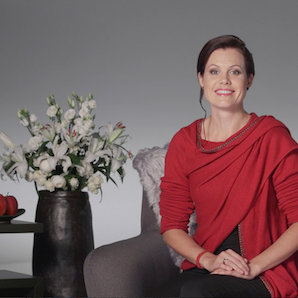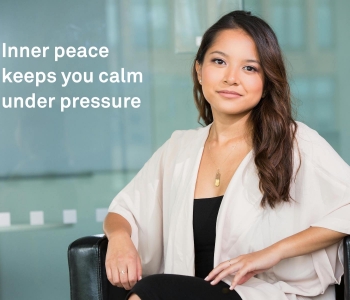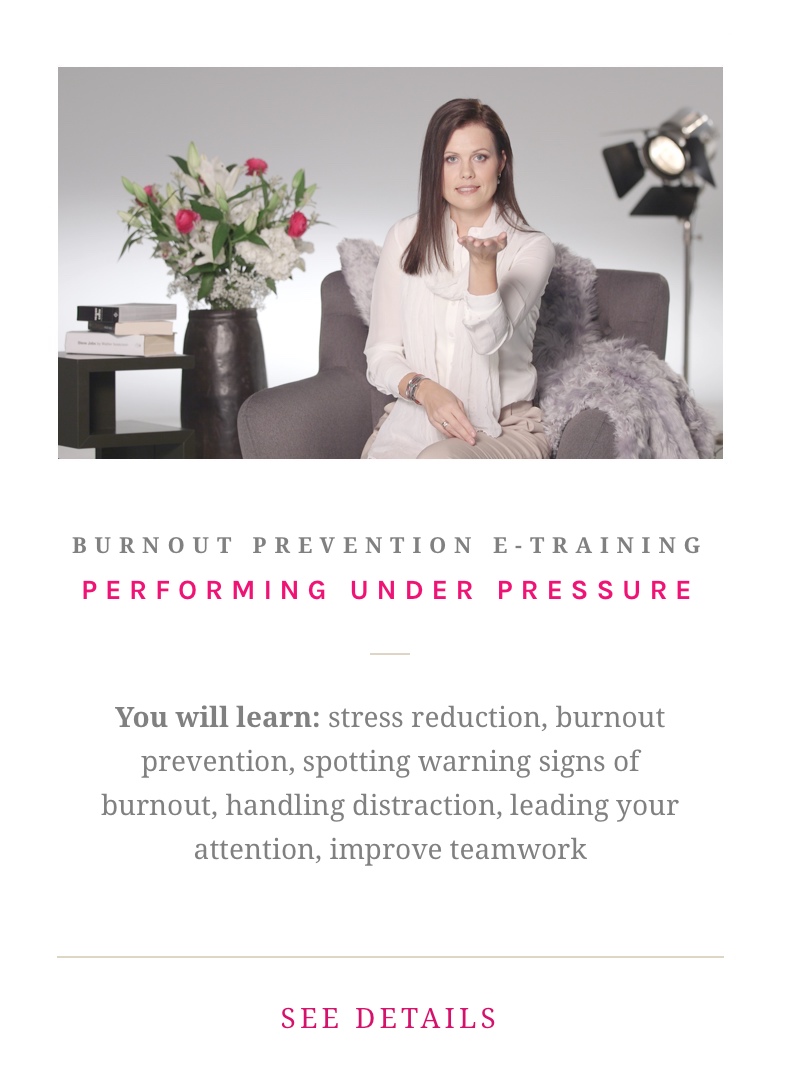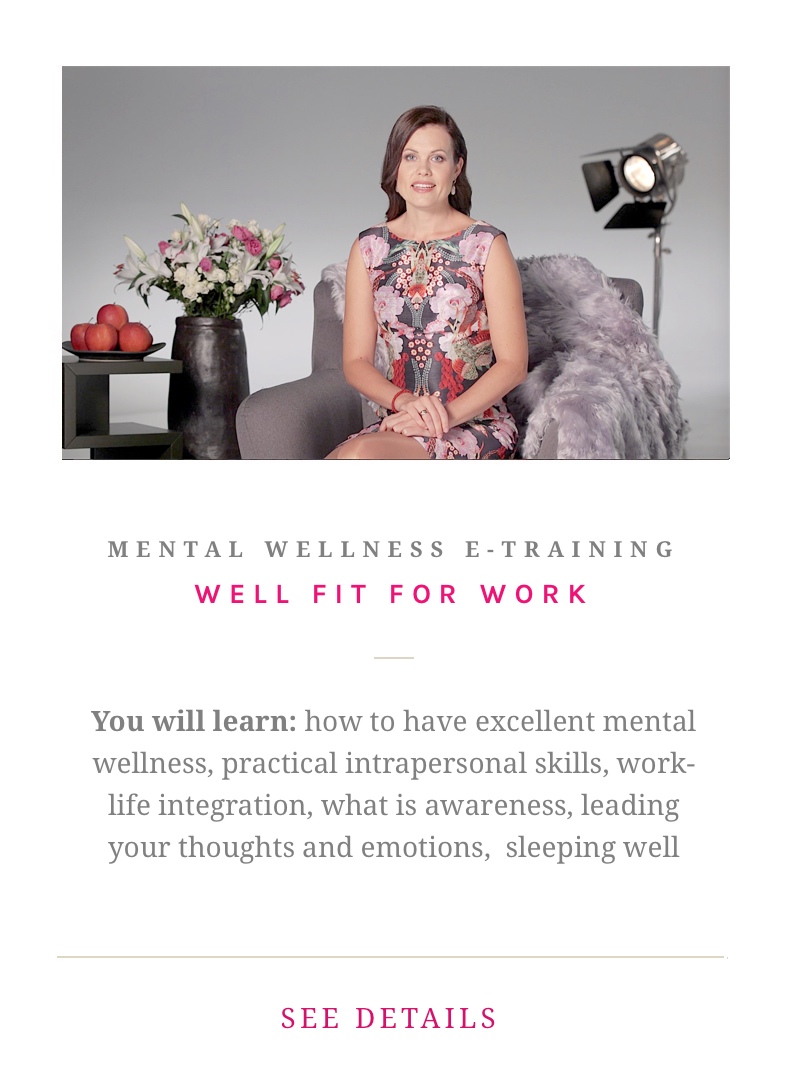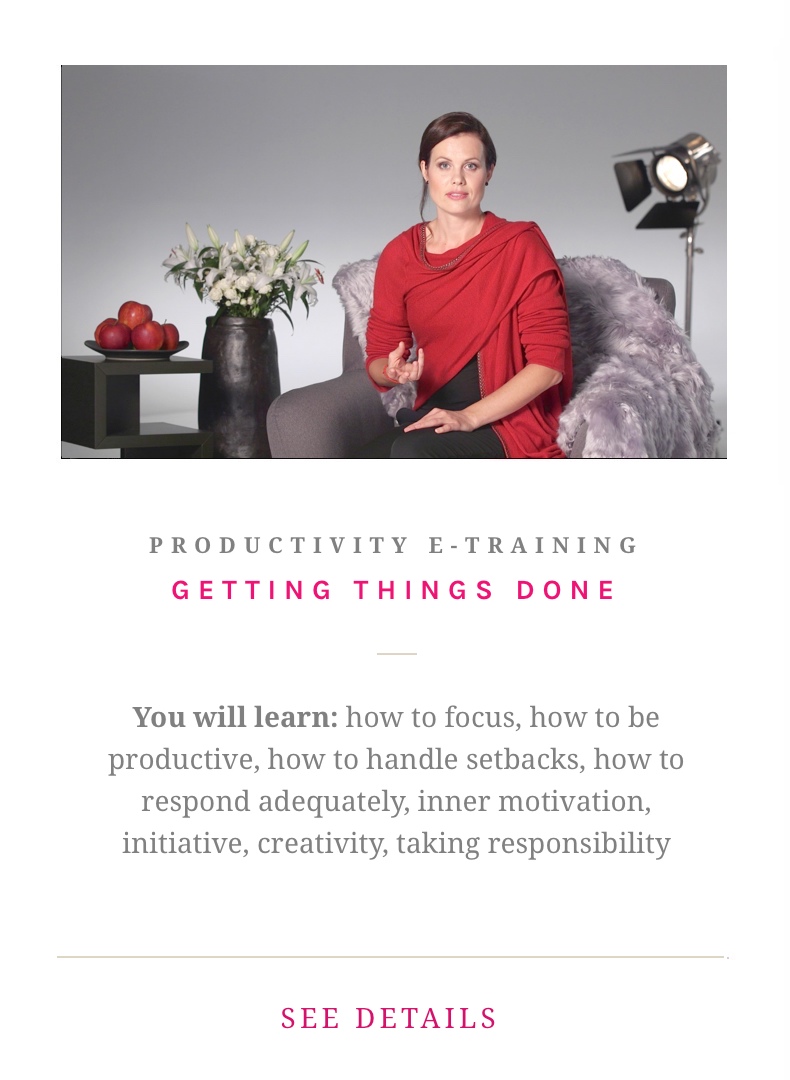Inner Peace Is the Foundation of Stress-Free Work
Leaders and professionals often overlook a simple truth: without inner calmness, there can be no creativity, sustained focus or sustainable success.
Inner calmness of human beings is a strategic business advantage. For people whose work depends on focus, adequate decision-making, and clear communication, keeping inner peace is the foundation of resilience.
When you lose your inner calm, anxiety or stress easily takes over. However, when you cultivate inner peace, wisdom, and creativity can support your work.
Are you aware that the state of your physical body follows the state of your mind? Inner calmness leads to wellbeing, while years of stressful action and inner noise, such as toxic thinking, lead to disease.
Holding on to your reactive patterns blocks you from your next success. The reactive decisions and habitual patterns that you ignore always set the stage for loss of productivity and health.
The Hidden Cost of a Busy Mind
Modern professionals often measure productivity by meetings attended, messages sent, or problems solved. But high activity doesn’t always equal high value. A restless mind, constantly reacting, can’t see the bigger picture.
Inner noise is an automatic inner reactivity in the form of constant mental turbulence that reduces conscious response and leads to stress, worry, and overthinking, which in turn drains your brain's capacity to deal with challenges successfully.
The loss of inner calm doesn’t happen overnight. It begins with minor inner tensions, such as anxiousness and stress. Then over time those turn into chronic stress and sleepless nights, as your racing mind refuses to switch off.
Next, your chronic stress transforms into anxiety (disorders), burnout, and from there, quite easily to depression. As we have pointed out earlier, the last phase of burnout and depression has an 86 to 92% overlap.
Even when facing mental health issues or illnesses, you can still be functioning, but no longer thriving. Your creativity shrinks, empathy fades, and decision-making becomes defensive rather than visionary.
In this state, leaders often become reactive instead of proactive. Instead of setting direction, they simply respond to crises. Instead of inspiring others, they transmit their stress to the team.
Workplaces mirror the emotional tone of their leaders. When calmness disappears at the top, anxiety and stress spread through every level of the organization. Soon, workplace stress makes people unfit to work, as explained in this video.
Why Inner Calmness Matters at Work
A truly calm mind is a serene but active, focused, and fully grounded state.
In a workplace context, inner calmness improves everything that matters: concentration, empathy, and communication.
Calmness allows your thinking to remain relevant to the topic. A calm mind is analytical and notices different options and opportunities clearly. When you possess a calm mind, you will respond with awareness, not by automatic inner impulse.
A calm leader or employee can listen with awareness, remain open-minded, and aga is able to create psychological safety. Sincerity, kindness, simplicity and telling the truth make situations easier, not harder.
All trust is earned, and a calm person understands personal responsibility.
Knowing the vision and mission, and understanding and explaining actual choices to others calmly, is the foundation of keeping trust and improving employee engagement.
People need to understand why their work matters and how it fits into a bigger picture. A calm-minded leader makes the cause stand out and allows ego to step back. In a caring mission-focused work environment, there are no power struggles, and there is enough time to pause, understand, and perceive fresh insights.
Calmness conserves mental resources and emotional energy. When your inner world is serene, external pressures become manageable.
Inner peace doesn’t mean avoiding challenges. It means meeting them without losing your harmony and inner strength. A strong mind is calm but focused and caring.
How Losing Inner Calm Leads to Burnout
When inner peace disappears, your nervous system operates in survival mode. Adrenaline and cortisol rise. You may feel alert, even productive at first, but underneath lies exhaustion.
Such a physiological stress response was designed by nature for short bursts in case of immediate danger when we, as humans, were living in nature and were attacked by wild animals. When such a flight-or-fight mode is combined with worry and anxiousness and lasts months or years, it slowly turns into burnout or anxiety disorders.
Scientific studies prove that chronic stress rewires your brain patterns. Minor setbacks feel threatening for a stressed person. Tasks that once felt exciting now seem heavy, and you carry them out without motivation or caring. Decision fatigue sets in.
Burnout never happens overnight, and this makes it fully preventable. In fact, burnout is 100% preventable if you have good intrapersonal skills and a calm mind.
Burnout is emotional depletion. As a result, you stop caring about what once mattered. Your ability to connect, empathize, and access creativity heavily declines.
Many professionals describe burnout as “losing themselves”; this happens to the point where they can perform tasks but can’t any longer see or find meaningful purpose. They press on despite being tired. Thus, mistakes become common, and engagement with what you do fades.
Today, only 21% of employees around the globe are engaged at work, according to the 2025 Gallup study, see the graph below.

In contrast, maintaining inner calmness protects your cognitive and emotional reserves. You can recover faster from setbacks, keep perspective during uncertainty, and maintain compassion for both yourself and your colleagues.
A calm-minded person can be fully engaged, and engagement of such persons in best-practice teams is up to 3 times, as the graph above demonstrates.
The Power of a Proactive Approach
Most workplace wellbeing initiatives focus on mental health first aid or supporting treatment rather than having a clear prevention-centric approach. They react when burnout, depression, and anxiety disorders appear.
Offering counselling or stress leave after burnout has already taken hold is needed; however, it arrives too late. As we have no intrapersonal education in our school system, people don’t have good enough self-leadership skills.
A busy and noisy mind is a result of lacking practical intrapersonal skills. As said, such a mind is reactive, suffering and stressed.
It is a must that all business leaders and workplaces flip the logic from attempting to repair the damage to giving people skills that help them to remain fit and well.
A proactive mental wellness approach focuses on training the mind. Training intrapersonal skills allows people to lead their thoughts, imaginations, and emotions at will without losing inner calm. Only when business leaders and employees both learn to replace inner reactions with calm responses can stress, anxiety, and (mental) illness be prevented.

Taking responsibility is the source of inner freedom and great work results.
That is why training your mind to remain calm, focused, and resilient should be your main aim. This is something that everyone needs, regardless of their position or years in the business.
A proactive mental wellness approach should include:
- Mind health training sessionsawareness-based intrapersonal skills, so that people learn to lead processes within their mind with ease.
- Creating calm environments that value focus at work over constant multitasking and disruptive reactive interactions.
- Regular breaks and micro-pauses to calm the nervous system and mind. The pest pause is here in a quiet room, where you can sit and relax.
- Leadership modelling, where calm and conscious decision-making sets the tone, and personal responsibility is valued.
- Open dialogue, both about work and your inner state. This needs to be about challenges at work as well as about the ability to lead thoughts or emotions at will under pressure, or reducing stress when the challenges become hard.
- Radical open-mindedness, when leaders are open about goals, short-term aims, and strategies, as well as about their own challenges and mental health situations, allows others to do the same. As a result, trust and support among the team members improve. Everyone is good at something, allowing a person to do what they do best, and keeping it all under one umbrella is what excellent leadership is all about.
Some of the most forward-looking conscious organizations already treat mental fitness as a core competency, and this sets them apart. However, for most workplaces, there is still a huge learning curve.
How is the situation in your team? Do your people improve and train their minds? How often?
A fit mind is trained just like a fit body; this is achieved through consistency, learning to lead awareness, and using intrapersonal skills.
Training the Mind is About Securing Resilience
So, what mental fitness means is responding consciously rather than reacting automatically.
Training your mind begins with simple awareness: noticing when your thoughts spiral into worry or judgment. By becoming aware of where you are and what you do. Being fully present builds metacognitive awareness, the ability to observe processes in your mind without becoming lost in those processes.
The easy and practical steps that everyone can apply are:
- Daily moments of stillness. A few minutes of quiet reflection can calm your system and reset your focus. Take regular breaks and disconnect from all action during this pause. A quiet room in the office can be helpful here.
- Always aim for single-tasking. Doing one thing at a time strengthens concentration and reduces anxiety. Besides, multitasking never works for most people anyway.
- Emotion check-ins. Noticing emotions as they arise helps you process them instead of suppressing them. All negative emotions can also be let go of if you apply the technique that is available in the book, which we introduced in one of our blogs. This truly works!
- Using your awareness consciously. Noticing tension in the body allows you to deal with it, and dealing with it reduces physical tensions. Also, observing your mind allows you to spot stress and anxiousness. Noticing alone is already powerful, as you now can do something about it. Taking the training ‘Performing Under Pressure’ is here the best solution as you learn stress reduction skills and get a very accurate self-evaluation with feedback.
- Purposeful reflection of the day. At the end of the work day, answer simple questions: What did I learn? We remind you that every failure and success is an opportunity to learn, and often failures teach more. Also ask: What can I let go of? Noticing what no longer serves you allows you to change it.
With regular practice, these 5 steps support your mental strength and improve your inner ability to remain composed under pressure. However, training your mind systematically is the best option. So take action now and see tenfold ROI!
|
Calm Leadership and Organizational Culture
Calm leadership is anchored and able to hold steady in uncertainty, so that others can find stability too.
When leaders know how to deal with their own inner pressures and stress, they can model composure and create ripple effects across teams.
Employees often mirror the emotional tone of their managers.
A calm-minded leader fosters open dialogue and balanced action; an anxious one breeds defensiveness and toxicity. In environments driven by fear or constant urgency, innovation dies. But in workplaces where calmness and care coexist, creativity and employee engagement can flourish.
That’s why workplace culture must evolve from performance-at-all-costs to performance through mental wellbeing.
Supporting professionals to manage their inner world builds a sustainable path to lasting success. So, it is about time to make mental fitness a shared value and every person's path to thriving.
Inner Peace as a Strategic Business Asset
By now, you should understand that inner peace has real commercial value. Calm, centered professionals make fewer errors, communicate more clearly, and collaborate more effectively.
Calm-minded professionals and leaders manage conflict with emotional maturity and maintain focus during volatility. In financial terms, that translates to lower turnover, fewer sick days, and higher engagement.
A workplace that nurtures inner calmness sends a strong message: our people matter and are valued. This attracts talent and builds loyalty. Employees feel safe to be creative, take initiative, experiment, and even fail as trust replaces fear.
In the long term, this approach fosters innovation. True creativity only arises when the mind is relaxed enough to explore new perspectives. As we’ve explained several times before, true innovation requires creativity and insight, and both only appear in inner silence.
When calm minds work together, they create cultures where clarity replaces confusion and collaboration replaces competition. This is the soil where sustainable growth takes root.
Despite technological progress, the essence of work remains human. People aren’t algorithms; they sense, observe, notice, think logically, feel different emotions, and need to know the actual meaning behind their work.
The more digital our systems become, the more essential it is to preserve the human touch, such as empathy, kindness and genuine connection. AI in that sense can be our supporter, but not a real replacer of humans if we value creativity, insights and intuition.
Inner calmness reconnects you to your actual warm-hearted humanity. When your mind is still, you listen better, speak kinder, and lead with authenticity. This improves wellbeing and enhances every metric that matters in business.
The Role of HR and Business Leaders
HR managers and business leaders play a pivotal role in shaping mentally healthy workplaces.
It begins with your own example.
When you are calm and lead with integrity, you can see this in others as a result. Be the change you want to see.
Accountability starts at the top: if you demonstrate harmony, health, resilience, transparency and care, others will follow.
Inner calmness is, in essence, the presence of awareness. Awareness or consciousness is silent. Inner silence is also your true being – your True Self. Becoming more silent and calmer allows you to act more consciously.
When you choose calm over hurry and being busy, you improve your own wellbeing and set a tone for everyone around you. Teams led by calm, conscious leaders are more resilient, creative, and loyal. They perform better not through fear, but through trust.
Conclusion: Calm Minds, Strong Organizations
In a world that celebrates speed, calmness is a quiet revolution. A base for a real mind health revolution that we promote on this site. This mental wellness revolution isn’t about us; it is about you, your personal sustainability, and your thriving people and good work results.
A calm mind is the real strength behind purposeful thinking, ethical leadership, conscious decision making, creative solutions and sustainable performance. Without it, intelligence becomes overthinking, and actions become reactionary. And then, instead of progress, you feel emotional turmoil and exhaustion.
By investing in proactive mental wellness and training the mind, organizations can reduce stress, prevent burnout, and unlock human potential at every level. Inner peace is a (collective) necessity for the future of work.
Because when calm-minded people work together, they create environments where mental wellness, innovation and sustainable work results thrive. This is a win-win-win case. Leaders win, people win, and business results win. And that isn’t all, from that your customers and your staff’s family members also gain positive experiences.
Conscious and calm leadership is a result of learning and using intrapersonal skills, which allows one to build a meaningful legacy that uplifts both people and performance.
|
This blog post is shared by Kaur Lass

